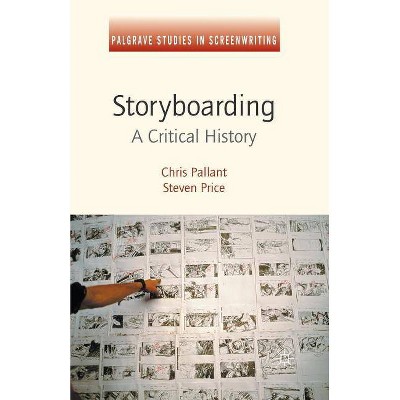Storyboarding - (Palgrave Studies in Screenwriting) by Steven Price & Chris Pallant (Hardcover)

Similar Products
Products of same category from the store
AllProduct info
<p/><br></br><p><b> About the Book </b></p></br></br>"This study provides the first book-length critical history of storyboarding. With roots in pre-cinematic experiments in the moving image, the form rapidly developed alongside animation, culminating in Disney's feature-length Snow White and the Seven Dwarfs. William Cameron Menzies similarly advanced the use of storyboarding for live-action cinema, although it was just one of his methods of production design for Gone with the Wind, often mistakenly described as a completely storyboarded film. Equally controversial is Alfred Hitchcock's use of storyboards, as for the notoriously problematic shower scene in Psycho. The form came to greater attention in the late 1970s in the 'cinema of effects' of Steven Spielberg and George Lucas; and with the emergence of today's new digital technologies, storyboarding has never been more prominent. This book examines all of these developments and more, drawing on archival research and illustrated with images from the beginnings of cinema to the present day"--<p/><br></br><p><b> Book Synopsis </b></p></br></br>This study provides the first book-length critical history of storyboarding. With roots in pre-cinematic experiments in the moving image, the form rapidly developed alongside animation, culminating in Disney's feature-length Snow White and the Seven Dwarfs. William Cameron Menzies similarly advanced the use of storyboarding for live-action cinema, although it was just one of his methods of production design for Gone with the Wind, often mistakenly described as a completely storyboarded film. Equally controversial is Alfred Hitchcock's use of storyboards, as for the notoriously problematic shower scene in Psycho. The form came to greater attention in the late 1970s in the 'cinema of effects' of Steven Spielberg and George Lucas; and with the emergence of today's new digital technologies, storyboarding has never been more prominent. This book examines all of these developments and more, drawing on archival research and illustrated with images from the beginnings of cinema to the present day.</p><p/><br></br><p><b> Review Quotes </b></p></br></br><br>"Storyboarding: a critical history is an important, timely and valuable contribution to a neglected field of scholarly study, not only for the selective case studies, but also for its general introduction to the field." (Pascal Lefèvre, Historical Journal of Film, Radio and Television, Issue 1, December, 2016) <p></p><br><p/><br></br><p><b> About the Author </b></p></br></br>Chris Pallant is Senior Lecturer in Film Studies at Canterbury Christ Church University, UK. He is the author of Demystifying Disney: A History of Disney Feature Animation (2011), the editor of Animated Landscapes: History, Form and Function (2015), and currently serves as Vice President for the Society for Animation Studies. <p/>Steven Price is Reader in English Literature at Bangor University, UK. He is the author of A History of the Screenplay (2013) and The Screenplay: Authorship, Theory and Criticism (2010), and is currently editor of the Journal of Screenwriting. <p/>
Price History
Price Archive shows prices from various stores, lets you see history and find the cheapest. There is no actual sale on the website. For all support, inquiry and suggestion messages communication@pricearchive.us




















